- Reducing the Payne Effect of the Natural Rubber/Sepiolite Composite by Introducing Modified Palm Stearin
Nureeyah Jehsoh*, Abdulhakim Masa**, ***, Indra Surya****, Hanafi Ismail*****, and Nabil Hayeemasae*, **,†

*Department of Rubber Technology and Polymer Science, Faculty of Science and Technology, Prince of Songkla University, Pattani Campus, 94000, Pattani, Thailand
**Research Unit of Advanced Elastomeric Materials and Innovations for BCG Economy (AEMI),
Faculty of Science and Technology, Prince of Songkla University, Pattani Campus, 94000, Pattani, Thailand
***Rubber Engineering & Technology Program, International College, Prince of Songkla University, Hat Yai, Songkhla, 90110, Thailand
****Department of Chemical Engineering, Faculty of Engineering, Universitas Sumatera Utara, Medan, 20155, Sumatera Utara, Indonesia
*****School of Materials and Mineral Resources Engineering, Engineering Campus, Universiti Sains Malaysia, 14300, Nibong Tebal, Penang, Malaysia- 개질된 Palm Stearin을 도입한 Natural Rubber/Sepiolite 복합체의 Payne 효과 개선 연구
Reproduction, stored in a retrieval system, or transmitted in any form of any part of this publication is permitted only by written permission from the Polymer Society of Korea.
Reducing Payne effect of natural rubber (NR) composite has been a major challenge in composite’s preparation. In this work, the composite based on NR and sepiolite was focused. Reduction of Payne effect was successfully performed by introducing modified palm stearin (mo-PS) as compatibilizer. Sepiolite was fixed at 20 phr whereby the mo-PS was ranged from 0-3 phr. The properties were studied through curing characteristics, tensile properties and dynamic properties. The presence of certain functionalities of mo-PS was corroborated by Fourier transform infrared (FTIR) analysis. From cure properties, scorch and curing times decreased as a function of mo-PS due to the role of mo-PS as a secondary curing additive in vulcanization process. It was also found that mo-PS improved modulus and tensile strength of composites. The improvement was due to improved NR-sepiolite interactions arising from hydrogen bonds formed in presence of mo-PS. This was clearly verified by observing the Payne effect.
Reduction of Payne effect was successfully performed by introducing modified palm stearin (mo-PS) as compatibilizer. It was also found that mo-PS improved modulus and tensile strength of composites. The improvement was due to improved natural rubber (NR)-sepiolite interactions arising from hydrogen bonds formed in presence of mo-PS. This was clearly verified by observing the Payne effect.
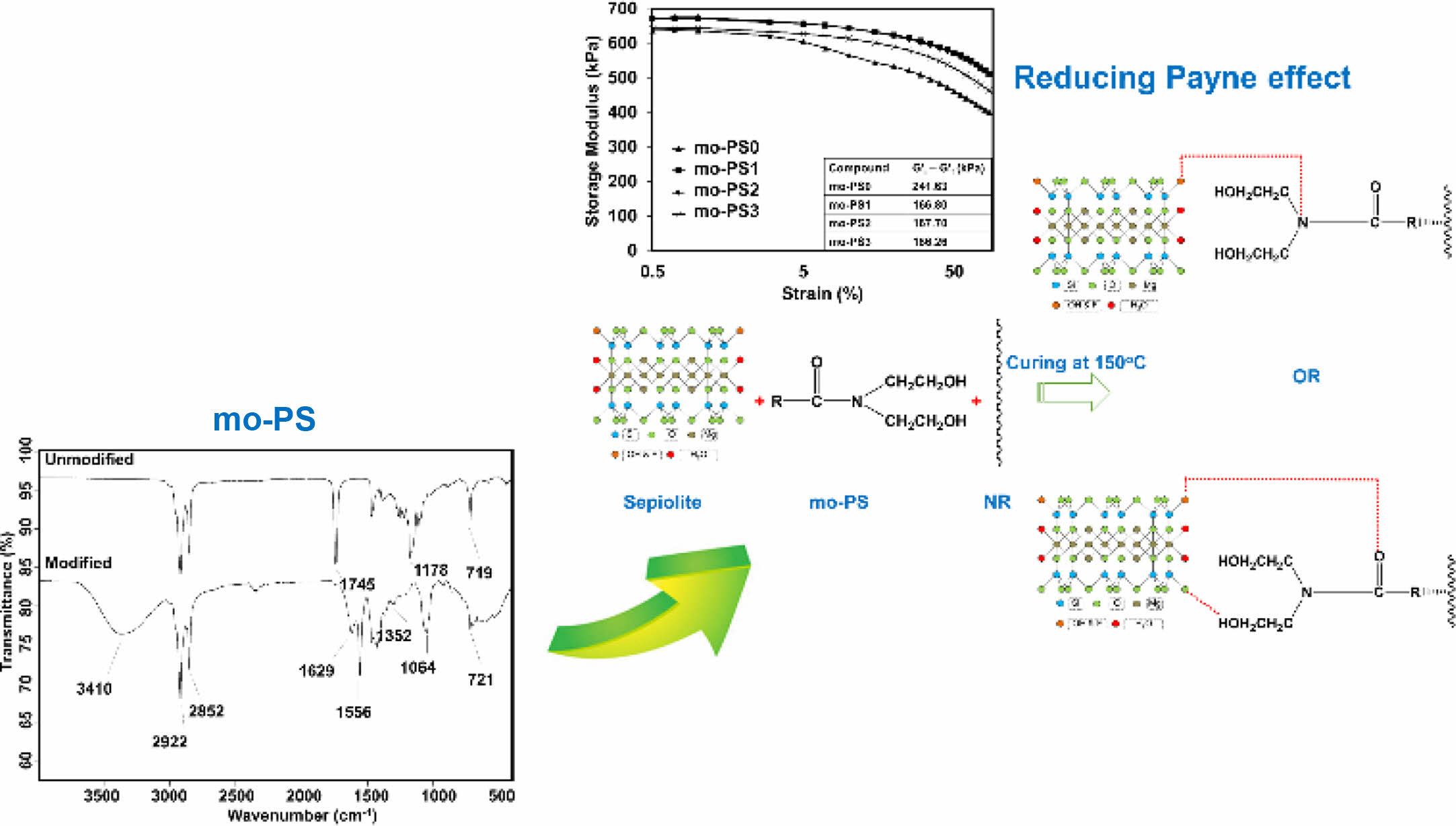
Keywords: natural rubber, sepiolite, modified palm stearin, payne effect, tensile properties.
The authors would like to thank Prince of Songkla University and Ministry of Higher Education, Science, Research and Innovation for the financial support under the Reinventing University Project (Grant Number: REV64052).
The addition of fillers to rubber has given several advantages to the composite materials. It has become the most important rubber ingredients after the curing additives.1-3 Recently, there have been various types of fillers regardless of their types, shapes and particle size.4-6 However, the effects of fillers on properties of rubbers were still not entirely understood. Considering fillers from clay family, sepiolite is one of its class which has very special characteristics compared to other clays.2 Sepiolite with the unit cell formula of Si12Mg8O30 (OH,F)4·(H2O)4·8H2O, is a microcrystalline hydrated magnesium silicate7,8 where hydroxyl group (OH) and fluorine (F) presented on the outer surface of it. Sepiolite is a needle-like morphology with 2-10 µm in length. It has a unique microfibrous structure consisting of tunnel-like micropore channel as displayed in Figure 1. Such tunnel-like channels are in an order of layers that arrange towards the fibrous direction.9,10
Because of the distinctive surface chemistry of sepiolite, the dispersibility of sepiolite throughout the non-polar NR is of interest since the use of sepiolite has brought to a higher filler-filler interaction especially at high content used. Previously, there has been an approach to conquer incompatibility between NR and sepiolite. For example, the use of modified rubber as compatibilizers.11 It was found that the modified rubber provided a remarkable influence on the overall performances of the composites. However, some properties may be missed out due to the change in matrix’s characteristics and less trial has been made to focus on the use of naturally occurring compatibilizers.
Here, the use of modified palm stearin (mo-PS) was introduced, mo-PS was synthesized from the fractionated product gained by crude palm oil (CPO) manufacture.12 Generally, the fatty acid portion of palm stearin contains highly saturated fats and triglyceride.13 Nonetheless, their methyl esters or triglycerides can react with amines to form the palm stearin that possesses special functionalities.13-15 This kind of chemical additive has been utilized in many industries such as soap, lubricant, anti-blocking agent, etc.16,17 However, it remains unexplored in the case of using as compatibilizer in NR composite.
The main point of using mo-PS as compatibilizer is to reduce the Payne effect of the composite.18,19 This phenomenon normally occurs when the filler is introduced to the rubber matrix. It strongly turns the viscoelastic behavior of rubber into a specific nonlinear behavior. The Payne effect has been the subject of several studies but to date remains not wholly explored to all composites.20 It is directly related to the filler characteristics for which it is unbearable to abandon either filler-filler interactions or rubber-filler interactions. The idea of this study is to tailor the rubber-filler interactions of NR/sepiolite composite in the presence of mo-PS as compatibilizer. Prior to any explanation, the specimens analyzed in this experiment have been carefully characterized in terms of the tensile properties and correlated them with the dynamic property.
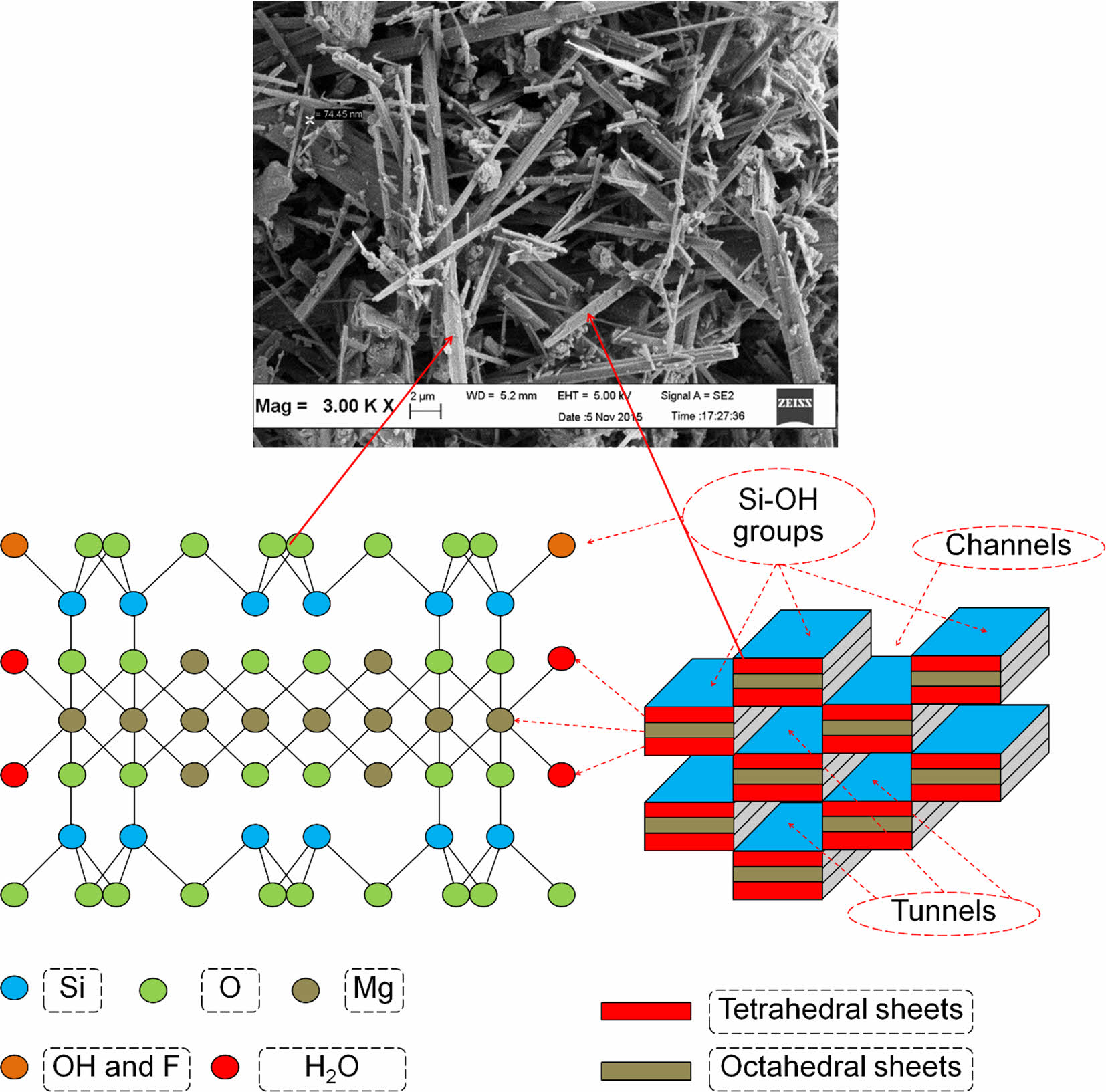
|
Figure 1 Morphology and structure of sepiolite.10 |
Materials. Table 1 shows the formulation of the NR/sepiolite composites in the presence of mo-PS as compatibilizer. The NR used in this experiment was Ribbed Smoked Sheet 3 grade (RSS 3) manufactured by Chalong Latex Industry Co., Ltd., Thailand. Sepiolite supplied by Hebei Dfl Minmet refractories Corporation, Shijiazhuang, Hebei, China was used as received. Sepiolite composed of 53.5 wt% of SiO2, 22.8 wt% of MgO, 1.93 wt% of Al2O3, 0.58 wt% of Fe2O3, 0.51 wt% of K2O, 0.17 wt% of CaO and other traces with the loss on ignition of 19.3%.21 Further information of this sepiolite can be referred to Table 2. Curing activator, ZnO and stearic acid were supplied by Imperial Chemical Co., Ltd., Bangkok, Thailand and Global Chemical Co., Ltd., Samut Prakan, Thailand respectively. N-cyclohexyl-2-benzothiazole sulfenamide (CBS) purchased from Flexsys America L.P., WV, USA was used as the curing accelerator, and the sulfur was supplied by Siam Chemical Co., Ltd., Samut Prakan, Thailand which was used as curing agent.
Modification of Palm Stearin. Synthesis of mo-PS was carried out based on the optimum conditions reported by Surya et al.14 It was synthesized in a reaction kettle equipped with a mechanical stirrer. The chemicals involved in the synthesis corresponds well to the chemical reaction shown in Figure 2. The mixture of palm stearin and diethanolamine was prepared and then added into the pre-mixture of methanol and sodium methoxide. The reaction was performed at temperature of 70 °C for 5 h. Later, the crude product was extracted with diethyl ether, and washed with saturated sodium chloride solution whereby the purification of the crude product was done by mixing it with anhydrous sodium sulfate, and concentrating by a rotary evaporator. The change in functionalities of mo-PS was characterized using Fourier transform infrared spectroscopy (FTIR).
Characterization of the mo-PS. The change in functionalities of mo-PS using attenuated total reflection-Fourier transform infrared spectroscopy (ATR-FTIR), a Bruker FTIR spectrometer (Tensor 27, Bruker Optik GmbH, Baden-Württemberg, Germany) with a smart durable single bounce diamond in the ATR cell. The spectrum was recorded from 4000-400 cm-1 in transmission mode after 32 scans per spectrum, with 4 cm-1 resolution.
Preparation of Composites. All the ingredients used were sequentially compounded in a Brabender (Plastograph® EC Plus, Mixer W50EHT 3Z, Germany). Each compound was prepared separately depending on the formulation suggested. After dumping from an internal mixer, the compound was then milled onto a two-roll mill to remove heat. The compounds were then vulcanized by compression molding. The time required for the vulcanization depends on the curing times observed from a Moving Die Rheometer (MDR).
Determination of Curing Characteristics. The curing characteristics test of the compounds were performed by using a moving die rheometer (Rheoline Mini MDR Lite, Prescott Instrument Ltd., UK) according to ASTM D5289. The temperature was set at 150 °C. The curing curves were implemented to interpret the curing characteristics of the composites.
Determination of Tensile Properties. Tensile properties were measured to observe the performance of the composites. The molded sheets were cut into dog-bone shapes for tensile properties determination which cover tensile modulus, tensile strength and elongation at break. The test was performed according to ASTM D412 using a universal tensile testing machine (Tinius Olsen, H10KS, Tinius Olsen TMC, Horsham, PA, USA) at a cross-head speed of 500 mm/min.
Payne Effect and Damping Characteristic of the Composites. The Payne effect and damping characteristic of NR/sepiolite composites were monitored using a rubber process analyzer model D-RPA 3000 (MonTech Werkstoffprüfmaschinen GmbH, Buchen, Germany). The test started with curing the samples at 150 °C to obtained fully vulcanized sample before cooling down until it reached 60 °C. The testing frequency was 10 Hz while the strain was varied from 0.5 to 90%. The data was recorded in terms of storage modulus (G' ) and damping factor (tan d). G' was later used to study the Payne effect by calculating according to the equation below;

Where G'i is the G' at 0.5% strain and G'f is the G' at 90% strain. Higher Payne effect indicates higher filler-filler interactions.
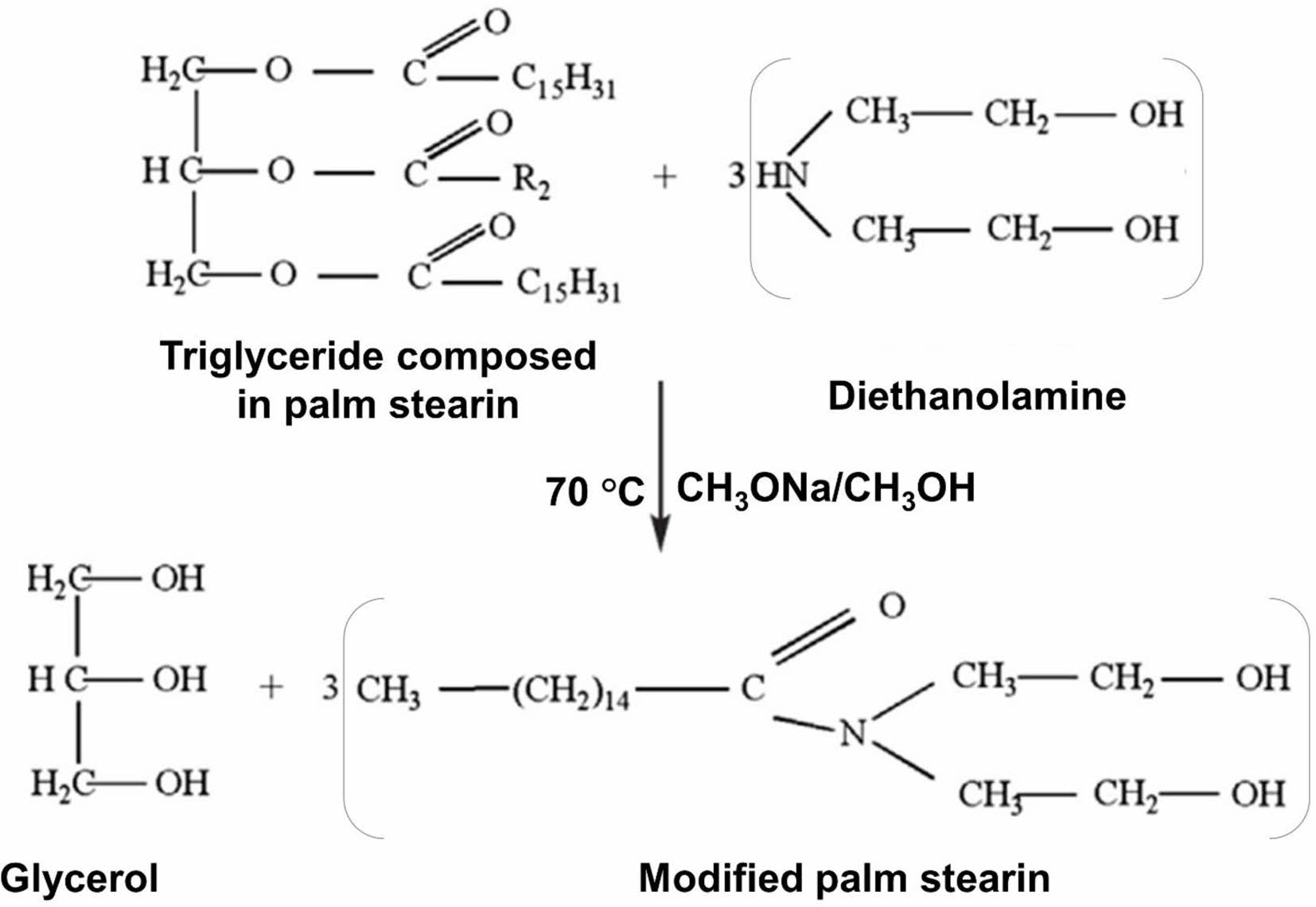
|
Figure 2 Proposed chemical reaction of mo-PS, adapted from Surya et al. 14 |
|
Table 1 Compound Formulation of the NR/Sepiolite Composites with and without mo-PS (Unit : phr) |

Functionalities of mo-PS. FTIR was used to confirm the presence of functionalities both in unmodified and modified palm stearin. Typical infrared spectra of these two products is illustrated in Figure 3 whereby the wavenumbers and their corresponding assignments are listed in Table 3. These two spectrums exhibited similar peaks of C-H stretch observed at wavenumbers of 2922 and 2852 cm-1, and CH2 rocking at 721 and 719 cm-1. These bands correspond to a long hydrocarbon chain of palm stearin which is originally from fatty acids. An umbrella mode at 1352 cm-1 was also observed due to a methyl group (CH3) attached to a carbon atom.22 The significant changes of bands observed for unmodified and mo-PS were strong band at 3410 cm-1, 1629 and 1556 cm-1, and 1064 cm-1 assigning to the O-H stretching, the C=O stretching and the amide C-N stretching, respectively. The obtained spectrum clearly corresponds to the functional groups present in mo-PS, as seen in the reaction scheme shown in Figure 2.
Curing Characteristics. Figure 4 exhibits the curing curves of the NR/sepiolite composites both with and without mo-PS as compatibilizer. The curing parameters obtained from the curing curves are also listed in Table 4. It was found that the minimum torque (ML) and the maximum torque (MH) increased with the addition of mo-PS. An increment of these two values clearly indicated a good sign that mo-PS has effectively provided the composite with better property. mo-PS helped to improve the interaction between NR and sepiolite which later resulted to increase the torque of the composites. This is because ML and MH could also indicate the development of physical and chemical interaction gained in the composite. Similar finding was seen for the torque differences (MH-ML). As this result indicates the degree of crosslinking and/or interaction within the composite system,23 this observation again ensured the compatibility of the NR and sepiolite in the presence of mo-PS as compatibilizer.
Another interesting findings were from the curing process of the composites in the presence of mo-PS as compatibilizer. As can be seen from Table 4, the scorch (ts1) and curing time (tc90) of the composites decreased upon the addition of mo-PS. As can be seen previously from Figure 2, diethanolamine was the main chemical in the reaction of mo-PS, which is also the main component that made mo-PS an alkaline substance. This has increased the pH of rubber compounds. Any additive that gives rubber compound more alkalinity, would lead to shorten the curing process of the compound. This is because the acidic chemical substance can absorp the accelerator which then retard the vulcanization process.14,24 It was, therefore, expected that the containment of amine in the mo-PS played major role in acelerating the cure rate of the composites.
Tensile Properties. Table 5 summarizes data obtained from the tensile properties namely tensile modulus at 100% (M100) and 300% (M300) strains, tensile strength and elongation at break. The addition of mo-PS has increased the tensile strength of the NR/sepiolite composites by improving up to 1 phr of mo-PS. Increased addition of mo-PS above this level reduced the strength of composites. The presence of mo-PS plays very important role to provide the composite with greater rubber-filler interactions. This interaction enables to exist through hydrogen bonding between the amide, carbonyl and/or hydroxyl groups available in the mo-PS and the hydroxyl and siloxane groups available on the sepiolite where the alkyl chain (-R-) available from the mo-PS attached with the rubber chain via dipole-dipole interaction. A plausible mechanism of interaction of NR and sepiolite in the presence of mo-PS is proposed in Figure 5. The improvement gained by this system enhanced the wetting and adhesion of filler to the rubber matrix, allowing the better transfer of stress the composites. This observation agreed well to the previous report proposed by Jehsoh et al.25 on the use of mo-PS in the composite based on NR and HNT. This is because the sepiolite is chemically similar to HNT. Therefore, such plausible interaction is also observed in this composite.
The reduction in tensile strength after 1 phr of mo-PS addition, may be associated to the plasticizing effect of mo-PS. When more mo-PS was used, it could act as external plasticizer to the rubber composites, sepiolite may subsequently have a possibility to re-agglomerate to certain area and generate the filler’s network. Such agglomerates became a stress concentration point and created a flaw at earlier stage of stretching. Thus, the energy required to break the sample is less at such condition. This phenomenon would provide a similar effect to the elongation at break of the NR/sepiolite composites.
As for the stresses at 100% (M100) and 300% (M300) strains (see Table 5), it can be seen that the M100 and M300 increased slightly with mo-PS content. There are two competitive factors affecting the modulus of the composites; one being due the influence of rubber-filler interactions26 another was being due to the re-agglomerating effect as discussed earlier. It resulted in harder and stiffer composites. Such finding is clearer when examining the M300. The result obtained here corresponded well the MH and MH-ML values in the preceding section.
Payne Effect and Damping Characteristic. The rubber-filler interactions was evaluated through the dynamic properties of the rubber composites. The obtained storage modulus and the damping characteristics of the composite results were later interpreted for their Payne effect. Figure 5 illustrates the G' and the Payne effect (G'i-G'f) of the NR/sepiolite composites with and without mo-PS. As the materials were tested after cure, so filler-filler and filler-rubber interactions as well as crosslinks contributed to the level of the G'. After the breakdown of filler-filler interactions at high strain, the G' of the composites is mainly affected by the crosslinks and rubber-filler interactions. It was found that G' of the composites containing mo-PS were higher than that of uncompatibilized counterpart. This is clear that the rubber-filler interactions was promoted in the presence of mo-PS. However, the use of high content of mo-PS (e.g., mo-PS3) may result to reduce G' value to considerable extend which is simply due to a plasticizing effect of mo-PS as stated earlier in the previous session.
Moreover, the Payne effects of all rubber composites were calculated from the difference between the G' at low and high strain amplitudes (see the Table embedded in the Figure 6). The value of G'i-G'f was found to be 241.63 kPa for the NR/sepiolite composites without mo-PS, and 166.80, 167.70 and 186.26 kPa for the composites with mo-PS at 1-3 phr respectively. This is a clear indication that introducing mo-PS has greatly influenced the Payne effect of the composites as the values of G'i-G'f reduced significantly. Such reduction of these values is associated to a decrease of filler’s network and indicates a high rubber-filler interactions.27 The Payne effect decreased with increasing mo-PS content to a minimum at 1 phr, thereafter increases slightly. The addition of mo-PS at only 1 phr is enough to cover the interactions between NR and sepiolite. However, a slight increase of these values after 1 phr of mo-PS may be responsible to a plasticizing effect of mo-PS itself, it may result to interfere the interaction of rubber and filler. Sepiolite may have a possibility to re-agglomerate and increase the Payne effect of the composites. This finding correlates to the tensile properties observed especially at 1 phr of mo-PS content.
Relationship between tan d and strains of the NR/sepiolite composites is shown in Figure 7. Higher tan d indicates lower elastic behavior. It is obvious that mo-PS has significantly influenced on the damping characteristics of the composites. Lower tan d was found for the composites containing the mo-PS as compatibilizer. This is a very good sign that mo-PS could enhance elastic response to the composite due to an improve in rubber-filler interaction. Moreover, lowest tan d was observed when adding the mo-PS at 1 phr. This corresponds well to the Payne effect of the composites, confirming that such amount is sufficient to include in the composite based on NR and sepiolite.
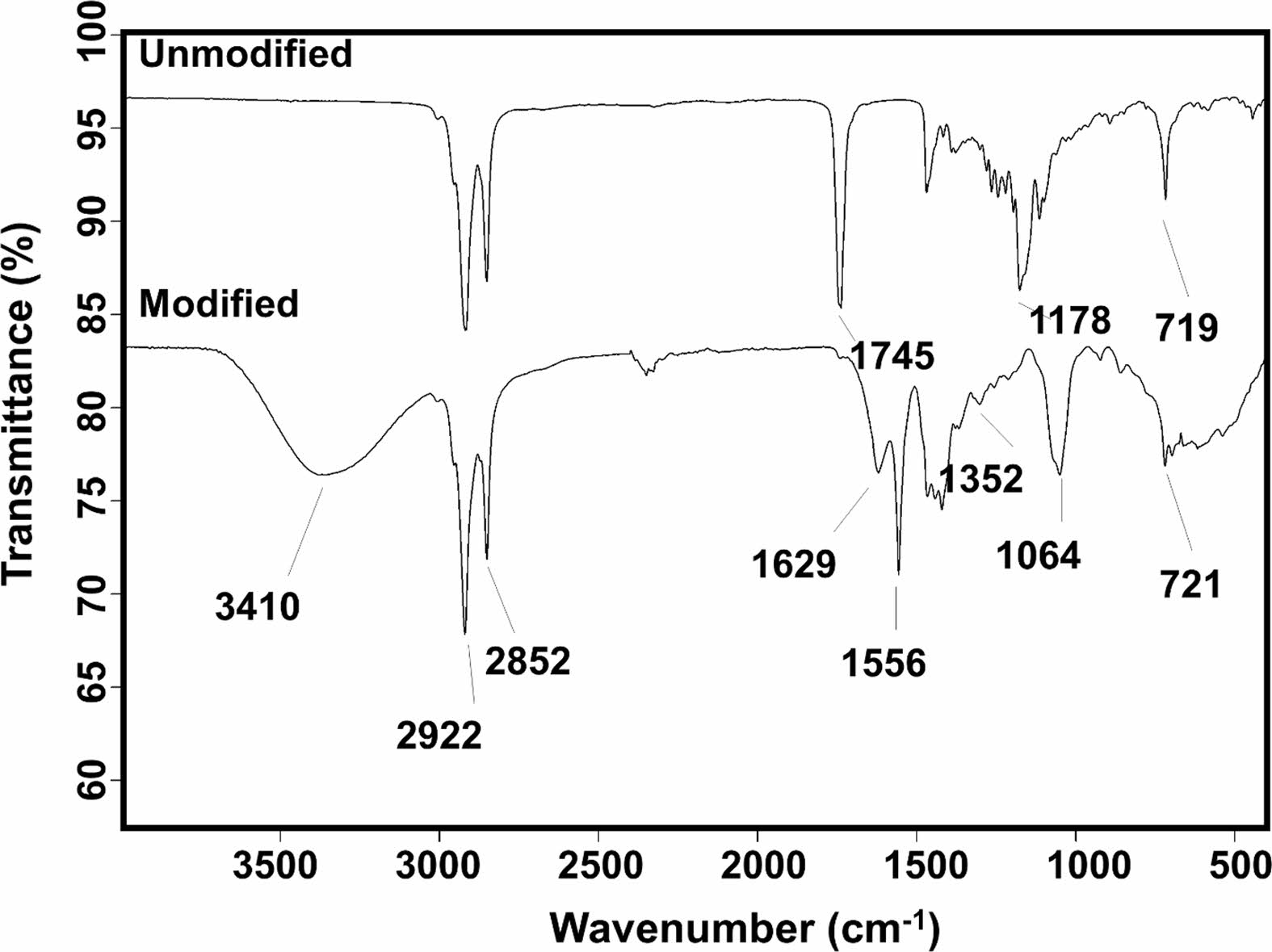
|
Figure 3 FTIR spectra of unmodified and modified palm stearin. |
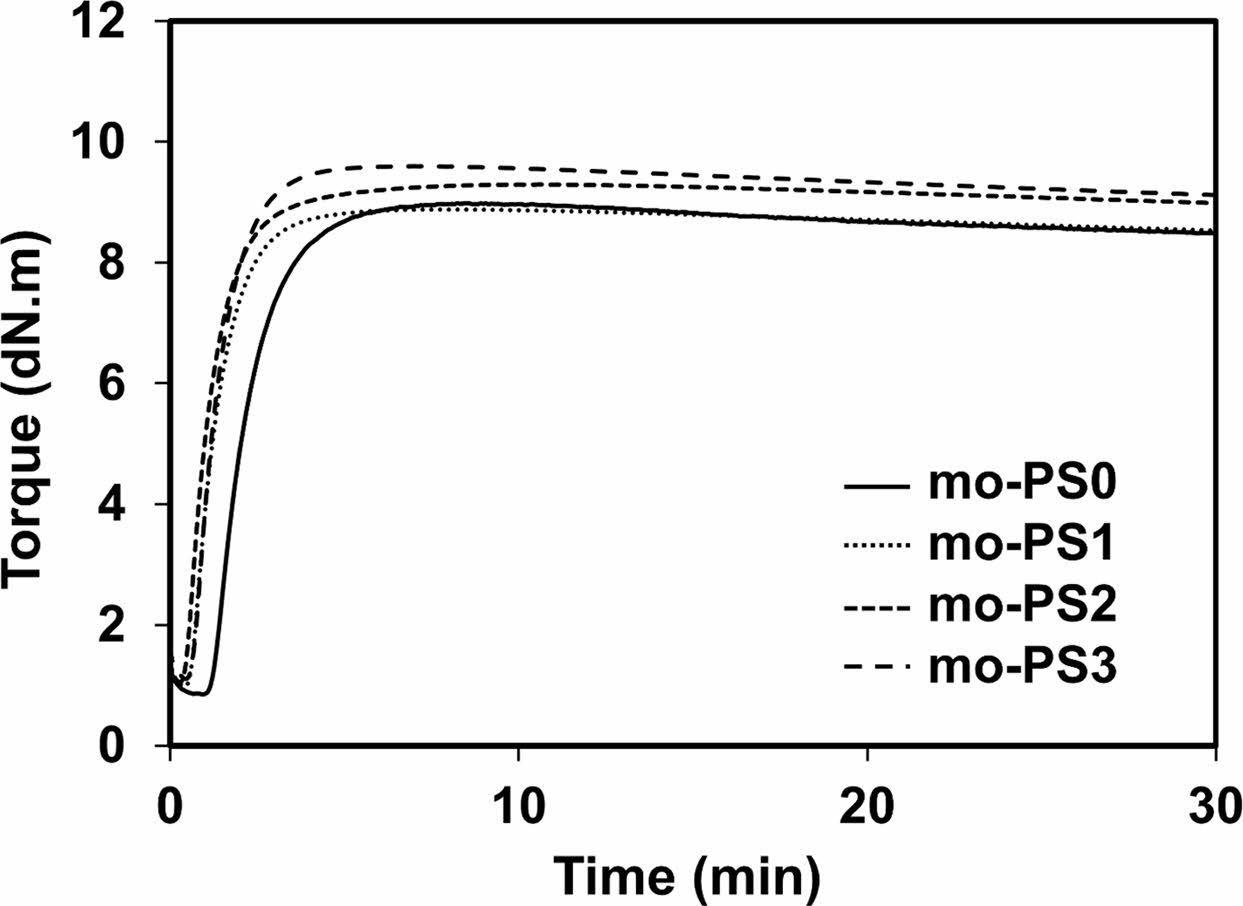
|
Figure 4 Curing curves of NR/sepiolite composites with and without mo-PS. |
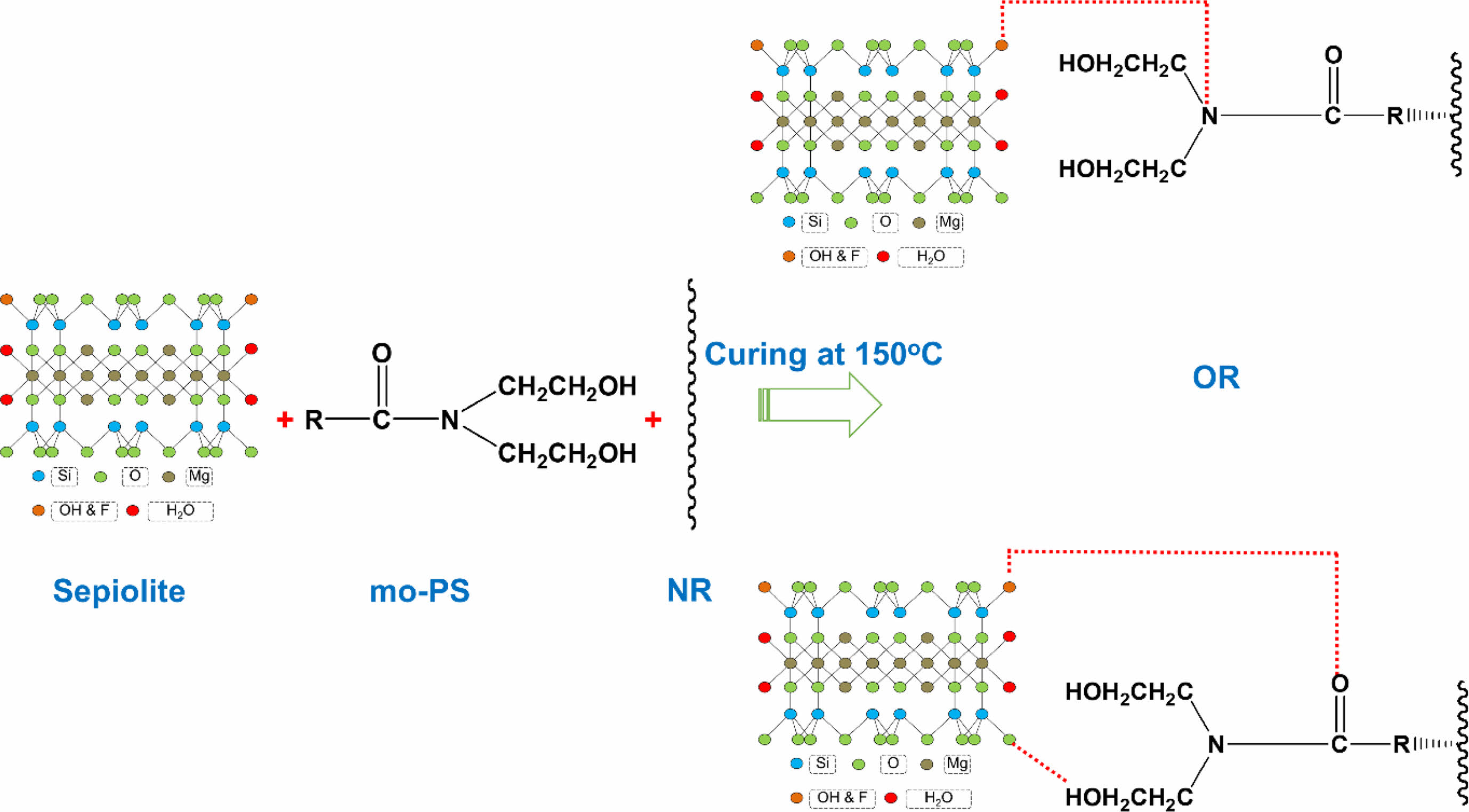
|
Figure 5 Proposed model of interactions and bonding between sepiolite and mo-PS. |
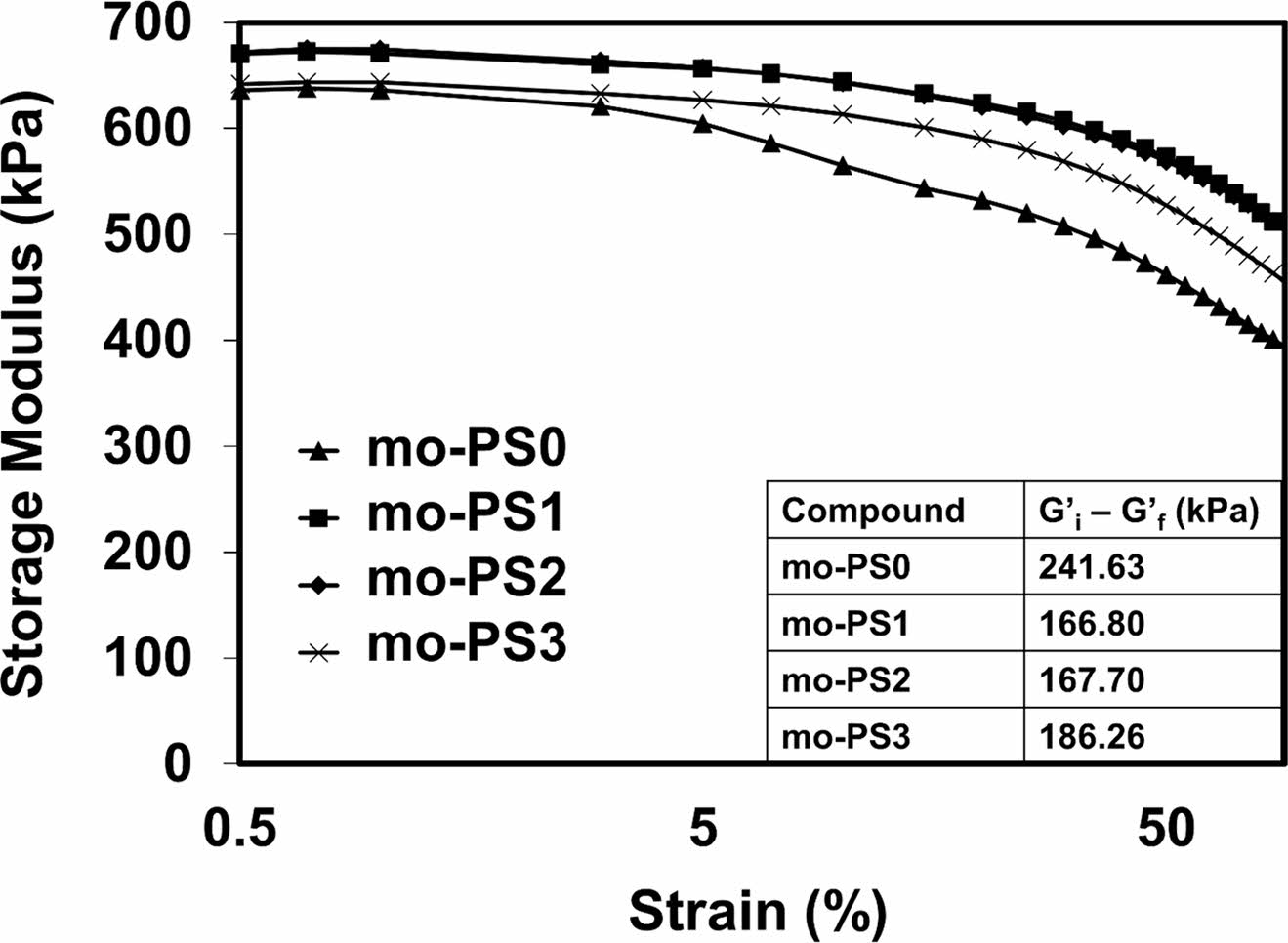
|
Figure 6 Storage modulus and Payne effect of NR/sepiolite composites with and without mo-PS. |
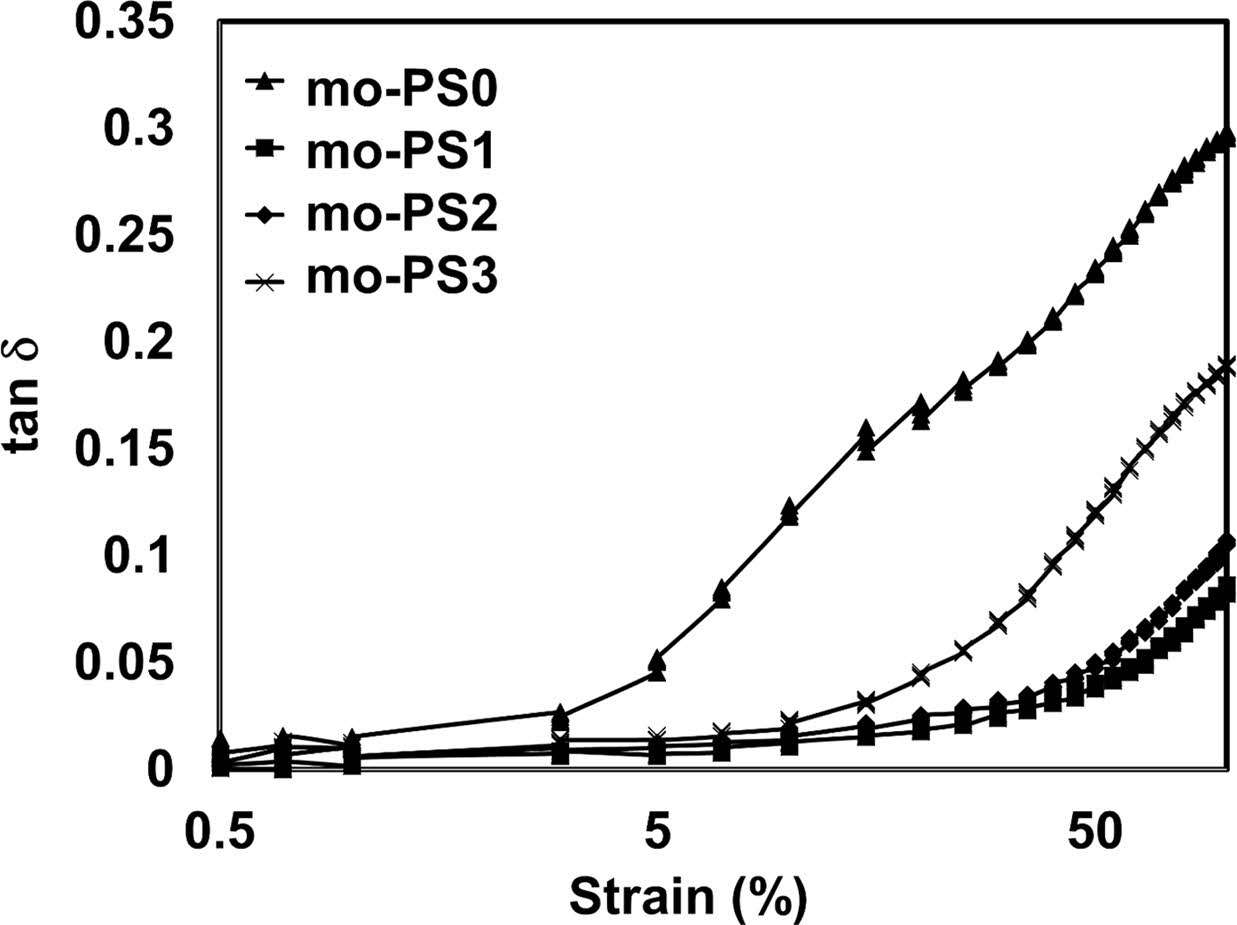
|
Figure 7 Tan delta of NR/sepiolite composites with and without mo-PS. |
|
Table 3 The Observed Peaks and Respective Assignments of Unmodified and Modified Palm Stearin |
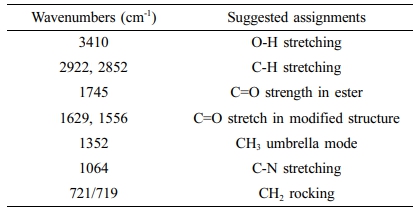
The overall performance of NR/sepiolite composites were visibly improved by adding mo-PS as compatibilizer. The main contributions are from the wax in nature of mo-PS which can improve the dispersion of sepiolite throughout the NR matrix, and the chemical structure that can improve the compatibility of NR and sepiolite. This has brought to an increase in modulus and tensile strength. The presence of mo-PS provided lower Payne effect, confirming the improvement of interaction between NR and sepiolite. In summary, it can be concluded that the addition of mo-PS at 1 phr is suggested for this composite. This recommendation can be further implemented for manufacturing the rubber products based on this composite. To some extent, this could lead to a modification of processing methods without requiring the use of commercial compatibilizers that are costly and complicated the process.
- 1. Arrighi, V.; McEwen, I. J.; Qian, H.; Serrano Prieto, M. B. The Glass Transition and Interfacial Layer in Styrene-butadiene Rubber Containing Silica Nanofiller. Polymer 2003, 44, 6259-6266.
-

- 2. Hayeemasae, N.; Ismail, H.; Azura, A. R. Recycled Polyethylene Terephthalate Filled Natural Rubber Compounds: Effects of Filler Loading and Types of Matrix. J. Elastomers Plast. 2011, 43, 429-449.
-

- 3. Zhong, B.; Jia, Z.; Luo, Y.; Jia, D.; Liu, F. Understanding the Effect of Filler Shape Induced Immobilized Rubber on the Interfacial and Mechanical Strength of Rubber Composites. Polym. Test. 2017, 58, 31-39.
-

- 4. Velez, J. S.; Velasquez, S.; Giraldo, D. Mechanical and Rheometric Properties of Gilsonite/Carbon Black/Natural Rubber Compounds Cured Using Conventional and Efficient Vulcanization Systems. Polym. Test. 2016, 56, 1-9.
-

- 5. Poh, B. T.; Suid, N. H. Effect of Zinc Oxide on the Viscosity and Adhesion Property of Epoxidized Natural Rubber/Acrylonitrile-butadiene Rubber-based Pressure-sensitive Adhesives. J. Vinyl Addit. Technol. 2016, 22, 410-414.
-

- 6. Pashaei, S.; Hosseinzadeh, S.; Syed, A. A. Studies on Coconut Shell Powder and Crysnanoclay Incorporated Acrylonitrile-butadiene Rubber/Styrene-butadiene Rubber (NBR/SBR) Green Nanocomposites. Polym. Compos. 2017, 38, 727-735.
-

- 7. Santaren, J.; Sanz, J.; Ruiz-Hitzky, E. Structural Fluorine in Sepiolite. Clays Clay Miner. 1990, 38, 63-68.
-

- 8. Bokobza, L.; Chauvin, J. P. Reinforcement of Natural Rubber: Use of In Situ Generated Silicas and Nanofibres of Sepiolite. Polymer 2005, 46, 4144-4151.
-

- 9. Baker, C. S. L.; Gelling, I.; Newell, R. Epoxidized Natural Rubber. Rubber Chem. Technol. 1985, 58, 67-68.
-

- 10. Ahlrichs, J.; Serna, C.; Serratosa, J. Structural Hydroxyls in Sepiolites. Clays Clay Miner. 1975, 23, 119-124.
-

- 11. Hayeemasae, N.; Ismail, H. Reinforcement of Epoxidized Natural Rubber through the Addition of Sepiolite. Polym. Compos. 2019, 40, 924-931.
-

- 12. Norizzah, A. R.; Chong, C. L.; Cheow, C. S.; Zaliha, O. Effects of Chemical Interesterification on Physicochemical Properties of Palm Stearin and Palm Kernel Olein Blends. Food Chem. 2004, 86, 229-235.
-

- 13. Che Man, Y. B.; Haryati, T.; Ghazali, H. M.; Asbi, B. A. Composition and Thermal Profile of Crude Palm Oil and Its Products. J. Am. Oil Chem. Soc. 1999, 76, 237-242.
-

- 14. Surya, I.; Ismail, H.; Azura, A. R. Alkanolamide as an Accelerator, Filler-Dispersant and a Plasticizer in Silica-filled Natural Rubber Compounds. Polym. Test. 2013, 32, 1313-1321.
-

- 15. Kolancilar, H. Preparation of Laurel Oil Alkanolamide from Laurel Oil. J. Am. Oil Chem. Soc. 2004, 8, 597-598.
-

- 16. Biermann, U.; Friedt, W.; Lang, S.; Lühs, W.; Machmüller, G.; Metzger, J. O.; Klaas, M. R.; Schäfer, H. J.; Schneider, M. P. New Syntheses with Oils and Fats as Renewable Raw Materials for the Chemical Industry. Angew Chem. Int. Ed. 2000, 39, 2206-2224.
-

- 17. Maag, H. Fatty Acid Derivatives: Important Surfactants for Household, Cosmetic and Industrial Purposes. J. Am. Oil Chem. Soc. 1984, 61, 259-267.
-

- 18. Payne, A. R. The Dynamic Properties of Carbon Black‐loaded Natural Rubber Vulcanizates. Part I. J. App. Polym. Sci. 1962, 6, 57-63.
-

- 19. Payne, A.; Whittaker, R. Low Strain Dynamic Properties of Filled Rubbers. Rubb. Chem. Technol. 1971, 44, 440-478.
-

- 20. Heinrich, G.; Klüppel, M.; Vilgis, T. A. Reinforcement of Elastomers. Current. Opinion. Solid State Mat. Sci. 2002, 6, 195-203.
-

- 21. Alves, L.; Ferraz, E.; Santarén, J.; Rasteiro, M. G.; Gamelas, J. A. Improving Colloidal Stability of Sepiolite Suspensions: Effect of the Mechanical Disperser and Chemical Dispersant. Minerals 2020, 10, 779.
-

- 22. Bhargava, R.; Wang, S. Q.; Koenig, J. L. FTIR Microspectroscopy of Polymeric Systems. Adv. Polym. Sci. 2003, 163, 137-191.
-

- 23. Rattanasom, N.; Saowapark, T.; Deeprasertkul, C. Reinforcement of Natural Rubber with Silica/carbon Black Hybrid Filler. Polym. Test. 2007, 26, 369-377.
-

- 24. Coran, A. Chemistry of the Vulcanization and Protection of Elastomers: A Review of the Achievements. J. Appl. Polym. Sci. 2003, 87, 24-30.
-

- 25. Jehsoh, N.; Surya, I.; Sahakaro, K.; Ismail, H.; Hayeemasae, N. Modified Palm Stearin Compatibilized Natural Rubber/Halloysite Nanotubes Composites: Reinforcement versus Strain-induced Crystallization. J. Elast. Plas. 2020, 53, 210-227.
-

- 26. Hayeemasae, N.; Sahakaro, K.; Ismail, H. Maleated Natural Rubber Compatibilized Natural Rubber/Halloysite Nanotubes Composites. Polym. Korea 2020, 44, 596-602.
-

- 27. Rooj, S.; Das, A.; Thakur, V.; Mahaling, R. N.; Bhowmick, A. K.; Heinrich, G. Preparation and Properties of Natural Nanocomposites Based on Natural Rubber and Naturally Occurring Halloysite Nanotubes. Mater. Des. 2010, 31, 2151-2156.
-

- Polymer(Korea) 폴리머
- Frequency : Bimonthly(odd)
ISSN 0379-153X(Print)
ISSN 2234-8077(Online)
Abbr. Polym. Korea - 2023 Impact Factor : 0.4
- Indexed in SCIE
 This Article
This Article
-
2022; 46(1): 6-12
Published online Jan 25, 2022
- 10.7317/pk.2022.46.1.6
- Received on Jun 27, 2021
- Revised on Aug 24, 2021
- Accepted on Sep 27, 2021
 Services
Services
- Full Text PDF
- Abstract
- ToC
- Acknowledgements
Introduction
Experimental
Results and Discussion
Conclusions
- References
Shared
 Correspondence to
Correspondence to
- Nabil Hayeemasae
-
*Department of Rubber Technology and Polymer Science, Faculty of Science and Technology, Prince of Songkla University, Pattani Campus, 94000, Pattani, Thailand
**Research Unit of Advanced Elastomeric Materials and Innovations for BCG Economy (AEMI),
Faculty of Science and Technology, Prince of Songkla University, Pattani Campus, 94000, Pattani, Thailand - E-mail: nabil.h@psu.ac.th
- ORCID:
0000-0002-9924-582X








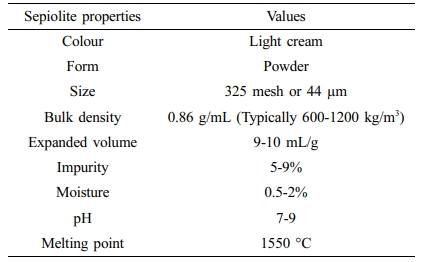
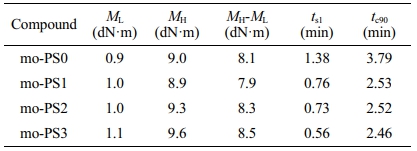
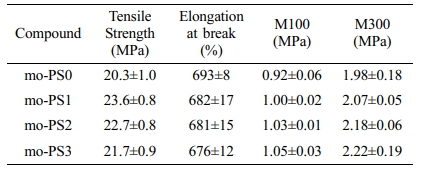
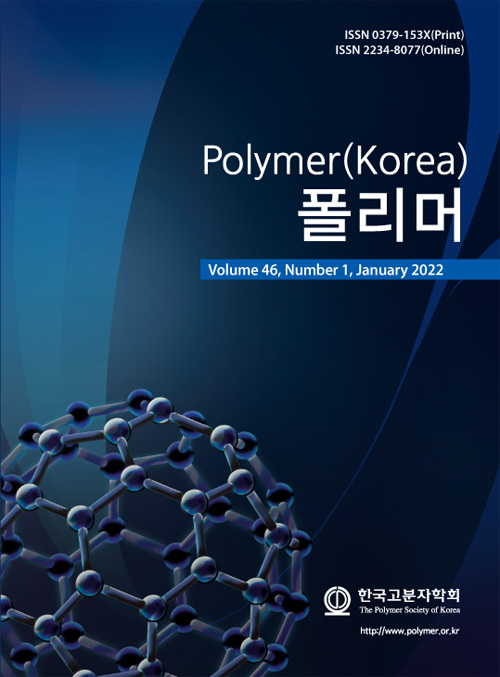
 Copyright(c) The Polymer Society of Korea. All right reserved.
Copyright(c) The Polymer Society of Korea. All right reserved.